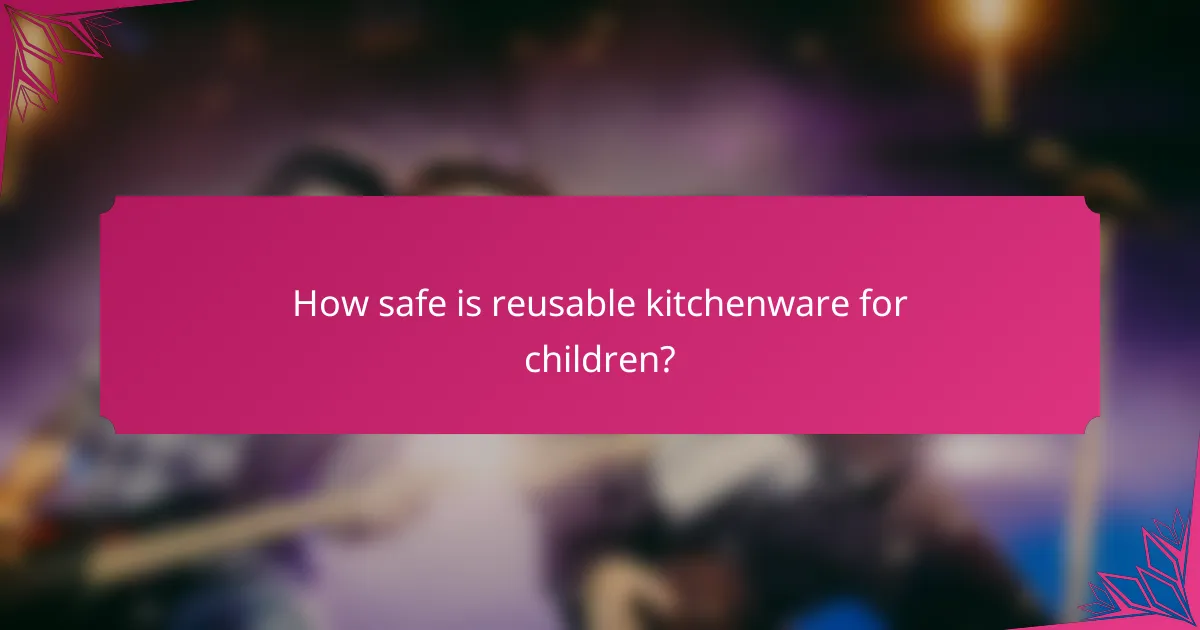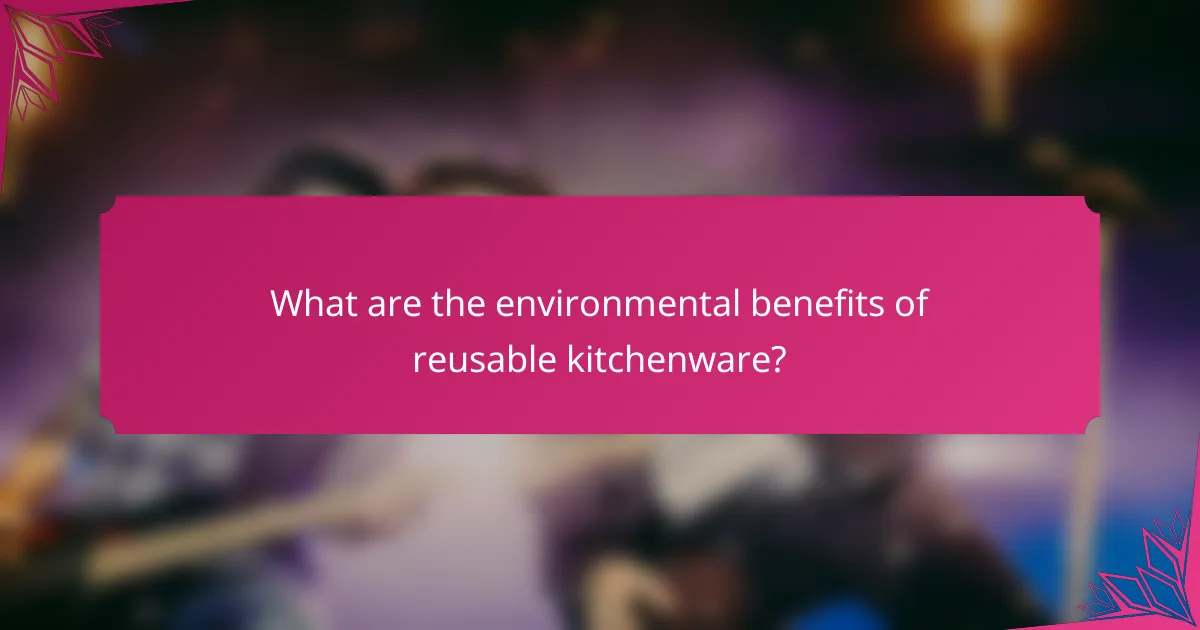Choosing the right reusable kitchenware is essential for families seeking safety, durability, and sustainability. Options like silicone baking mats, stainless steel containers, and bamboo utensils not only withstand daily use but also ensure a non-toxic environment for children. By prioritizing materials that meet safety standards, parents can create a healthier cooking and eating space for their families.

What are the best reusable kitchenware options for families?
The best reusable kitchenware options for families include silicone baking mats, stainless steel containers, bamboo utensils, glass storage jars, and reusable food wraps. These items are not only durable and safe but also promote sustainability in the kitchen.
Silicone baking mats
Silicone baking mats are a versatile alternative to parchment paper, providing a non-stick surface for baking. They can withstand high temperatures, making them suitable for various cooking methods, and are easy to clean, often being dishwasher safe.
When selecting silicone mats, look for those that are BPA-free and certified for food safety. They typically last for several years, reducing waste and saving money over time.
Stainless steel containers
Stainless steel containers are ideal for storing food, as they are durable, non-toxic, and resistant to rust and corrosion. These containers come in various sizes, making them perfect for meal prep, leftovers, or packing lunches.
Consider opting for containers with airtight lids to keep food fresh longer. They are also easy to clean and can be recycled at the end of their life, contributing to a more sustainable kitchen.
Bamboo utensils
Bamboo utensils are an eco-friendly choice for cooking and serving. They are lightweight, durable, and naturally antibacterial, making them safe for use with non-stick cookware.
When using bamboo utensils, avoid soaking them in water for extended periods to prevent warping. Regularly oiling them can help maintain their condition and extend their lifespan.
Glass storage jars
Glass storage jars are perfect for organizing pantry items and leftovers. They are non-reactive, meaning they won’t leach chemicals into food, and they allow you to see contents easily.
Choose jars with airtight seals to keep food fresh and prevent spills. Glass jars are also microwave and dishwasher safe, making them convenient for everyday use.
Reusable food wraps
Reusable food wraps, often made from beeswax or plant-based materials, are an excellent alternative to plastic wrap. They can be molded around food items and containers, providing a sustainable way to keep food fresh.
To maintain their longevity, wash them with cold water and mild soap. Avoid using them with raw meat or in high-heat situations, as this can compromise their effectiveness.

How safe is reusable kitchenware for children?
Reusable kitchenware can be safe for children if made from appropriate materials and designed with safety standards in mind. Parents should look for products that prioritize non-toxic materials and are free from harmful chemicals to ensure a safer cooking and eating environment for their kids.
Non-toxic materials
Choosing reusable kitchenware made from non-toxic materials is crucial for children’s safety. Options like silicone, stainless steel, and certain types of glass are generally considered safe. Avoid items made from plastics that may leach harmful substances, especially when heated.
When selecting kitchenware, look for labels indicating materials are BPA-free or phthalate-free. These certifications can help ensure that the products are safer for children’s use.
FDA-approved products
Using FDA-approved products is a reliable way to ensure that reusable kitchenware meets safety standards. The FDA evaluates materials for food safety, which includes assessing their potential to release harmful substances. Products that carry FDA approval are generally deemed safe for food contact.
Parents should check for FDA approval on kitchenware items, especially those intended for children’s use. This can include utensils, plates, and storage containers, providing peace of mind regarding their safety.
Free from harmful chemicals
It’s essential to select reusable kitchenware that is free from harmful chemicals, such as lead, cadmium, and other toxic substances. Many manufacturers now offer products that are specifically labeled as free from these harmful elements, making it easier for parents to make informed choices.
To ensure safety, consider researching brands that prioritize chemical safety and transparency. Reading product reviews and checking for certifications can help identify kitchenware that meets these safety criteria.

What are the durability features of reusable kitchenware?
Durability features of reusable kitchenware include heat resistance, impact resistance, and scratch resistance. These characteristics ensure that kitchenware can withstand daily use while maintaining safety and functionality.
Heat resistance
Heat resistance refers to a material’s ability to withstand high temperatures without deforming or releasing harmful substances. Many reusable kitchenware items, such as silicone and stainless steel, can endure temperatures ranging from 200°C to 300°C, making them suitable for cooking and baking.
When selecting heat-resistant kitchenware, look for products that specify their temperature limits and are labeled as safe for oven or microwave use. Avoid using plastic items that do not indicate heat resistance, as they may melt or leach chemicals at high temperatures.
Impact resistance
Impact resistance is the capacity of kitchenware to resist damage from drops or collisions. Materials like tempered glass and certain plastics are designed to absorb shocks, reducing the likelihood of breakage. This feature is particularly important for families with children, where accidental drops are common.
To ensure impact resistance, choose kitchenware that is specifically marketed as shatterproof or drop-resistant. Regularly inspect items for cracks or chips, as these can compromise their durability and safety.
Scratch resistance
Scratch resistance indicates how well a material can withstand surface abrasions without showing wear. High-quality reusable kitchenware, such as ceramic-coated or stainless steel items, often features scratch-resistant surfaces that maintain their appearance over time.
To protect against scratches, use utensils made from silicone or wood instead of metal on non-stick surfaces. Regularly check for scratches, as they can harbor bacteria and affect the longevity of your kitchenware.

How to choose family-friendly reusable kitchenware?
When selecting family-friendly reusable kitchenware, prioritize safety, durability, and ease of use. Look for materials that are non-toxic, easy to clean, and suitable for various family needs.
Material considerations
Choosing the right material is crucial for family-friendly reusable kitchenware. Opt for items made from food-grade stainless steel, BPA-free plastic, or silicone, as these materials are generally safe and durable. Avoid items with harmful chemicals like phthalates or lead, which can pose health risks.
Additionally, consider the environmental impact of the materials. Biodegradable options or those made from recycled materials can be more sustainable choices for eco-conscious families.
Size and capacity
Size and capacity are important factors when selecting reusable kitchenware for families. Choose containers that can hold sufficient portions for meals, snacks, or leftovers, typically ranging from 500 ml to 2 liters depending on your needs. Smaller items are great for kids’ lunches, while larger containers work well for family meals.
Consider nesting or stackable designs for easy storage. This can help save space in your kitchen while ensuring you have the right sizes available for different occasions.
Ease of cleaning
Ease of cleaning is essential for maintaining reusable kitchenware, especially in busy households. Look for dishwasher-safe items to simplify the cleaning process. Non-stick surfaces can also make cleaning easier, reducing the need for scrubbing.
Additionally, consider whether the items can withstand high temperatures, as this affects their longevity and cleanliness. Avoid materials that may warp or degrade over time with frequent washing.

What are the environmental benefits of reusable kitchenware?
Reusable kitchenware significantly reduces waste and promotes sustainability by minimizing reliance on disposable items. By choosing durable alternatives, families can contribute to a healthier planet while enjoying practical, long-lasting products.
Reduction of single-use plastics
Using reusable kitchenware directly decreases the demand for single-use plastics, which are a major contributor to environmental pollution. Items like plastic utensils, plates, and straws often end up in landfills or oceans, harming wildlife and ecosystems.
For example, a family that switches from disposable plates to reusable ones can prevent hundreds of plastic items from being discarded each year. This shift not only reduces waste but also encourages a culture of sustainability within households.
Lower carbon footprint
Reusable kitchenware helps lower the overall carbon footprint associated with food preparation and consumption. Manufacturing single-use items typically involves high energy consumption and greenhouse gas emissions, while durable products require less frequent replacement.
For instance, using a stainless steel water bottle instead of plastic can save significant resources over time. Families can further enhance their eco-friendly practices by opting for locally produced reusable items, which often have a smaller carbon footprint due to reduced transportation emissions.

What are the cost-effective options for reusable kitchenware?
Cost-effective options for reusable kitchenware include materials like stainless steel, glass, and silicone, which provide durability and safety without breaking the bank. These alternatives not only reduce waste but also save money over time compared to disposable items.
Stainless Steel Kitchenware
Stainless steel kitchenware is a popular choice due to its durability and resistance to rust and corrosion. Items like pots, pans, and storage containers made from stainless steel can last for years, making them a wise investment.
When selecting stainless steel products, look for those labeled as food-grade. This ensures they are safe for food contact and free from harmful chemicals. Prices can vary, but many quality options are available in the low to mid-range, often between $10 and $50 depending on the item.
Glass Kitchenware
Glass kitchenware is another excellent option, especially for food storage and baking. Glass is non-reactive, meaning it won’t leach chemicals into food, and it can withstand high temperatures, making it safe for ovens and microwaves.
Consider purchasing tempered glass containers with airtight lids for optimal food preservation. While glass can be more expensive upfront, many options are available for under $30, and their longevity can lead to savings over time.
Silicone Kitchenware
Silicone kitchenware offers flexibility and heat resistance, making it ideal for baking mats, molds, and spatulas. Silicone is lightweight, easy to clean, and can withstand temperatures ranging from -40°C to 230°C, making it versatile for various cooking tasks.
When choosing silicone products, ensure they are labeled as food-safe and free from fillers. Prices for silicone items typically range from $5 to $25, providing affordable options for families looking to reduce waste.
